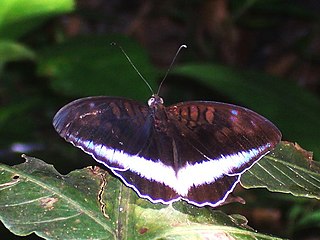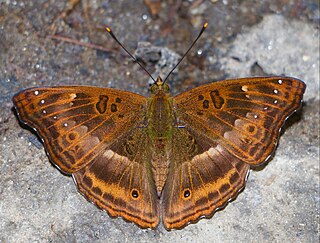
Danainae is a subfamily of the family Nymphalidae, the brush-footed butterflies. It includes the Daniadae, or milkweed butterflies, who lay their eggs on various milkweeds on which their larvae (caterpillars) feed, as well as the clearwing butterflies (Ithomiini), and the tellervini.

The Nymphalidae are the largest family of butterflies, with more than 6,000 species distributed throughout most of the world. Belonging to the superfamily Papilionoidea, they are usually medium-sized to large butterflies. Most species have a reduced pair of forelegs and many hold their colourful wings flat when resting. They are also called brush-footed butterflies or four-footed butterflies, because they are known to stand on only four legs while the other two are curled up; in some species, these forelegs have a brush-like set of hairs, which gives this family its other common name. Many species are brightly coloured and include popular species such as the emperors, monarch butterfly, admirals, tortoiseshells, and fritillaries. However, the under wings are, in contrast, often dull and in some species look remarkably like dead leaves, or are much paler, producing a cryptic effect that helps the butterflies blend into their surroundings.

Tirumala limniace, the blue tiger, is a species of butterfly found in South Asia, and Southeast Asia that belongs to the brush-footed butterfly family, Nymphalidae. More specifically it is part of the crows and tigers or danaid group. This butterfly shows gregarious migratory behaviour in southern India. In some places, it may be found in congregations with Danaus genutia, Tirumala septentrionis, Euploea sylvester, Euploea core, Parantica aglea, and at high elevations, with Parantica nilgiriensis, on Crotalaria.

The Limenitidinae are a subfamily of butterflies that includes the admirals and relatives. The common names of many species and genera reference military ranks or – namely the Adoliadini – titles of nobility, in reference to these butterflies' large size, bold patterns, and dashing flight. In particular, the light stripe running lengthwise across the wings of many Limenitidini has reminded earlier authors of officers' shoulder marks and epaulets.

Euploea klugii, the brown king crow or king crow, is a butterfly from the family Nymphalidae found in India and Southeast Asia. The species was first described by the entomologist Frederic Moore in 1858.

The Satyrini is one of the tribes of the subfamily Satyrinae. It includes about 2200 species and is therefore the largest tribe in the subfamily which comprises 2500 species.

Lasippa viraja, the yellowjack sailer, is a species of nymphalid butterfly found in South Asia.

Hestina is a genus of butterflies in the family Nymphalidae subfamily Apaturinae. The genus is found in the East Palearctic and Southeast Asia.

Neptis is a large genus of butterflies of Old World tropics and subtropics. They are commonly called sailer butterflies or sailers, or more precisely typical sailers to distinguish them from the related blue sailer (Pseudoneptis).

Lepidoptera Indica was a 10 volume work on the butterflies of the Indian region that was begun in 1890 and completed in 1913. It was published by Lovell Reeve and Co. of London. It has been considered the magnum opus of its author, Frederic Moore, assistant curator at the museum of the East India Company. Frederic Moore described a number of new species through this publication. Moore was a splitter, known for careless creation of synonyms, sometimes placing the same species in more than one genus.

Tanaecia is a genus of butterflies of the family Nymphalidae.

Lassipa is a genus of Asian butterflies distributed from India to Sulawesi. They resemble Neptis but are smaller and marked yellow not white.

Rohana parvata, the brown prince, is an Indomalayan butterfly of the family Nymphalidae. The species was first described by Frederic Moore in 1857. It is found from Sikkim to Assam, Bhutan and Nepal. The subspecies R. p. burmana(Tytler, 1940) is found in Myanmar.

Lassipa heliodore, the Burmese lascar, is an Indomalayan butterfly of the family Nymphalidae first described by Johan Christian Fabricius in 1787.














